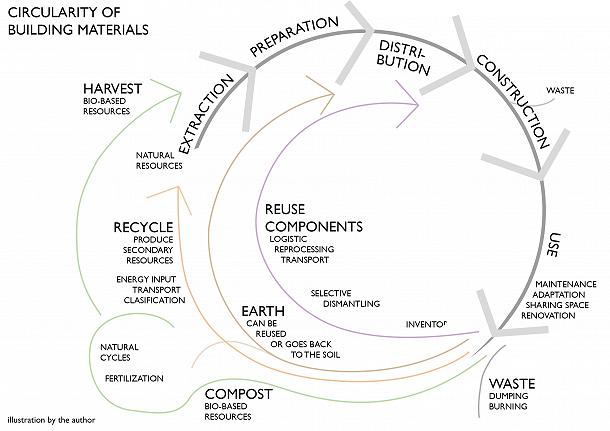
Circular architecture aims to consider buildings and building materials in a cycle.
Using and reusing buildings for a long time instead of demolishion
Circularity begins with preserving existing buildings, maintaining them and adapting them to new uses. If a new need for space arises, the first step is to check whether there are existing buildings that can be adapted.
Flexibility and foresighted planning
When planning new buildings, this means planning the floor plans in such a way that they offer maximum flexibility. In order to realise the building turnaround, various players in the construction process, from planning to technical expertise, trades and maintenance, must work together. A new process culture of cooperation is needed. Circular construction strategies
To ensure that building materials can be reused in a circular way, several basic rules must be observed. The building material should consume little energy during production, transport routes to the construction site should remain short and the service life and repair options should be as long as possible. At the end of its useful life, the building material should either be reusable or compostable as a biogenic material.
:: BIOBASED BUILDING MATERIALS
Building materials such as fibres, wood or bamboo bind CO2 as they grow and store it in the building throughout the entire use phase. There is now a wide range of building materials made from plants. Hemp, straw, rice husks and reeds are the best known, but seaweed and mushroom mycelium also have exciting properties as building materials.
Biobased building materials are compostable and can be used as fertiliser.
:: LEHM
Loam is a building material that can be found in many parts of the world and is almost 100% recyclable. The mixture of clay, silt and sand varies in composition depending on the location. Clay has been used as a building material in almost every country for 100 years. There are various techniques, load-bearing with rammed earth and adobe (unbaked clay bricks), light clay techniques such as half-timbered construction and various clay plasters.
With the right technique and the right design (protective roof and dry foundations), earth can become a long-lasting building, but the material can also be converted back into a raw material at the end of the utilisation phase by simple means and become a new building material without any loss of quality.
:: REUSE
The reuse of building materials is currently a much-discussed topic. What materials are available to us that can be used on construction sites? These can come from existing buildings, but can also be residual materials from industry, trade, infrastructure, etc. Planning with re-use materials is a very exciting task, as the material is at the beginning of the planning process and thus helps to determine the form.
Training
Architecture students learn about these forward-looking topics as part of the BASEhabitat degree programmes. They deal with earth building techniques, test various regenerative building materials in workshops, deal with re-use materials and apply what they have learnt in their designs and on construction site projects during their studies.
www.basehabitat.org/master / www.basehabitat.org/postgrad
architects for future have compiled a catalogue of 10 demands for a building revolution.